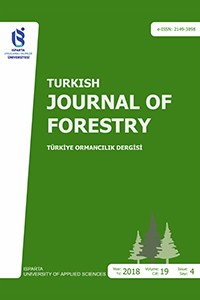Abstract
Son yıllarda Deng Entropisi oldukça ilgi çekmekte ve birçok uygulama alanında kendine yer bulmaktadır. Deng Entropisi Dempster-Shafer Delil Teorisi alanında geliştirilmiş temel olasılık değerlendirmesine dayalı bir entropik eşitliktir. Bu çalışmada Deng Entropisi’ne dayalı yeni bir taksonomik çeşitlilik indeksi önerilmektedir. Çalışmada 8 kompleks (örnek alan) verisi kullanılmıştır, her bir kompleksin değerleri belirlenmiş ve sonuçlar birbirleri ile karşılaştırılmıştır. Elde edilen sonuçlar, yeni önerilen indeksin taksonomik çeşitlilik hesabında kullanılabilir nitelikte olduğunu göstermektedir. Bununla birlikte yeni önerilen indeksin performansının daha iyi anlaşılması için, çok sayıda ve değişik ekolojik veriler ile onun diğer geleneksel ve taksonomik çeşitlilik indeksleri ile kıyaslamasına yönelik çalışmalara ihtiyaç bulunmaktadır.
Keywords
References
- Clarke, K.R., Warwick, R.M., 1998. A taxonomic distinctness index and its statistical properties. Journal of Applied Ecology, 35(4): 523-531.
- Deng, Y., 2016. Deng entropy. Chaos, Solitons & Fractals, 91: 549-553.
- Faith, D.P., 1992. Conservation evaluation and phylogenetic diversity. Biological Conservation, 61(1): 1-10.
- Mert, A., Özkan, K., 2017. Studies on taxonomic diversity of plant communities and modeling its potential distribution in Yazılı Canyon Nature Park, Turkey. Journal of Environmental Biology, 38(6): 1267-1274.
- Özkan, K., 2016. Biyolojik Çeşitlilik Bileşenleri (α, β ve γ) Nasıl Ölçülür? Süleyman Demirel Üniversitesi, Orman Fakültesi Yayın No: 98, ISBN: 976-9944-452-89-2, Isparta.
- Özkan, K., Süel, H., 2008. Endemic plant species in a karstic canyon (Mediterranean Region, Turkey): Relation to relief and vegetation diversity. Polish Journal of Ecology, 56(4): 709-715.
- Özkan, K., Mert A., Şenol A., Özdemir S., 2018. Macrotakdivozkan, http://www.kantitatifekoloji.net/takdivozkan
- Peet, R.K., 1974. The measurement of species diversity. Annual Review of Ecology and Systematics, 5: 285-307.
- Pielou, E.C., 1975. Ecological Diversity. Wiley, Newyork.
- Rao, C.R., 1982. Diversity and dissimilarity coefficients: A unified approach. Theoretical Population Biology, 21(1): 24-43.
- Ricotta, C., Avena, G.C., 2003. An information-theoretical measure of taxonomic diversity. Acta Biotheoretica, 51(1): 35-41.
- Shannon, C.E., 1948. A mathematical theory of communication. The Bell System Technical Journal, 27: 379-423.
- Simpson E.H., 1949. Measurement of diversity. Nature, 163: 688.
- Vane-Wright R.I., Humphries C.J., Williams P.H., 1991. What to protect?—Systematics and the agony of choice. Biological Conservation, 55(3): 235-254.
- Warwick, R.M., Clarke K.R., 1995. New “biodiversity” measures reveal a decrease in taxonomic distinctness with increasing stress. Marine Ecology Progress Series, 129: 301-305.
- Westhoff, V., Van Der Maarel, E., 1973. The Braun-Blanquet Approach. In: R.H. Whittaker (Ed.), Handbook of Vegetation Science 5: Ordination and classification of communities. Junk, The Hague, Netherland, pp. 617-726.
Abstract
Recently, Deng Entropy has been received attention and began to use in many real application. That entropic measure was improved in the Dempster-Shafer Evidential Theory (DSET) and based on the basic probability assignment. The present study offers a new proposed taxonomic diversity measure based on Deng Entropy. In the study, the data obtained from 8 complexes (sample plots) were used. The values of the complexes were computed and compared with each other. According to the results, the new proposed taxonomic diversity measure seems to be promising in estimation of taxonomic diversity. However, further and more detail studies should be done to better understand the performance of the new proposed measure by using various ecological data and comparing it to the other taxonomic or traditional diversity indices.
Keywords
References
- Clarke, K.R., Warwick, R.M., 1998. A taxonomic distinctness index and its statistical properties. Journal of Applied Ecology, 35(4): 523-531.
- Deng, Y., 2016. Deng entropy. Chaos, Solitons & Fractals, 91: 549-553.
- Faith, D.P., 1992. Conservation evaluation and phylogenetic diversity. Biological Conservation, 61(1): 1-10.
- Mert, A., Özkan, K., 2017. Studies on taxonomic diversity of plant communities and modeling its potential distribution in Yazılı Canyon Nature Park, Turkey. Journal of Environmental Biology, 38(6): 1267-1274.
- Özkan, K., 2016. Biyolojik Çeşitlilik Bileşenleri (α, β ve γ) Nasıl Ölçülür? Süleyman Demirel Üniversitesi, Orman Fakültesi Yayın No: 98, ISBN: 976-9944-452-89-2, Isparta.
- Özkan, K., Süel, H., 2008. Endemic plant species in a karstic canyon (Mediterranean Region, Turkey): Relation to relief and vegetation diversity. Polish Journal of Ecology, 56(4): 709-715.
- Özkan, K., Mert A., Şenol A., Özdemir S., 2018. Macrotakdivozkan, http://www.kantitatifekoloji.net/takdivozkan
- Peet, R.K., 1974. The measurement of species diversity. Annual Review of Ecology and Systematics, 5: 285-307.
- Pielou, E.C., 1975. Ecological Diversity. Wiley, Newyork.
- Rao, C.R., 1982. Diversity and dissimilarity coefficients: A unified approach. Theoretical Population Biology, 21(1): 24-43.
- Ricotta, C., Avena, G.C., 2003. An information-theoretical measure of taxonomic diversity. Acta Biotheoretica, 51(1): 35-41.
- Shannon, C.E., 1948. A mathematical theory of communication. The Bell System Technical Journal, 27: 379-423.
- Simpson E.H., 1949. Measurement of diversity. Nature, 163: 688.
- Vane-Wright R.I., Humphries C.J., Williams P.H., 1991. What to protect?—Systematics and the agony of choice. Biological Conservation, 55(3): 235-254.
- Warwick, R.M., Clarke K.R., 1995. New “biodiversity” measures reveal a decrease in taxonomic distinctness with increasing stress. Marine Ecology Progress Series, 129: 301-305.
- Westhoff, V., Van Der Maarel, E., 1973. The Braun-Blanquet Approach. In: R.H. Whittaker (Ed.), Handbook of Vegetation Science 5: Ordination and classification of communities. Junk, The Hague, Netherland, pp. 617-726.
Details
| Primary Language | Turkish |
|---|---|
| Journal Section | Orijinal Araştırma Makalesi |
| Authors | |
| Publication Date | December 30, 2018 |
| Acceptance Date | December 16, 2018 |
| Published in Issue | Year 2018 Volume: 19 Issue: 4 |


